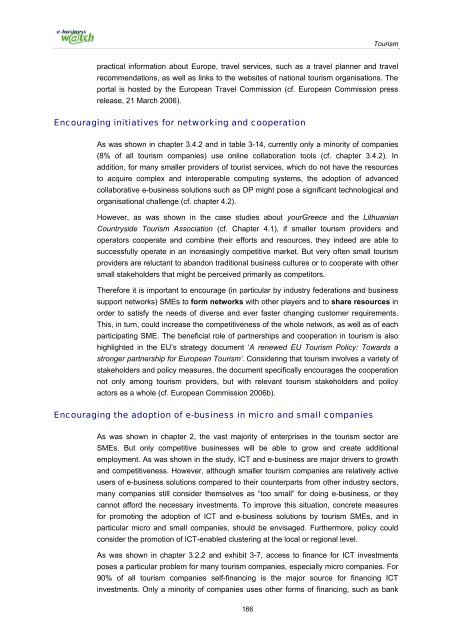ICT and e-business in the tourism industry ICT adoption ... - empirica
ICT and e-business in the tourism industry ICT adoption ... - empirica
ICT and e-business in the tourism industry ICT adoption ... - empirica
Create successful ePaper yourself
Turn your PDF publications into a flip-book with our unique Google optimized e-Paper software.
Tourism<br />
practical <strong>in</strong>formation about Europe, travel services, such as a travel planner <strong>and</strong> travel<br />
recommendations, as well as l<strong>in</strong>ks to <strong>the</strong> websites of national <strong>tourism</strong> organisations. The<br />
portal is hosted by <strong>the</strong> European Travel Commission (cf. European Commission press<br />
release, 21 March 2006).<br />
Encourag<strong>in</strong>g <strong>in</strong>itiatives for network<strong>in</strong>g <strong>and</strong> cooperation<br />
As was shown <strong>in</strong> chapter 3.4.2 <strong>and</strong> <strong>in</strong> table 3-14, currently only a m<strong>in</strong>ority of companies<br />
(8% of all <strong>tourism</strong> companies) use onl<strong>in</strong>e collaboration tools (cf. chapter 3.4.2). In<br />
addition, for many smaller providers of tourist services, which do not have <strong>the</strong> resources<br />
to acquire complex <strong>and</strong> <strong>in</strong>teroperable comput<strong>in</strong>g systems, <strong>the</strong> <strong>adoption</strong> of advanced<br />
collaborative e-<strong>bus<strong>in</strong>ess</strong> solutions such as DP might pose a significant technological <strong>and</strong><br />
organisational challenge (cf. chapter 4.2).<br />
However, as was shown <strong>in</strong> <strong>the</strong> case studies about yourGreece <strong>and</strong> <strong>the</strong> Lithuanian<br />
Countryside Tourism Association (cf. Chapter 4.1), if smaller <strong>tourism</strong> providers <strong>and</strong><br />
operators cooperate <strong>and</strong> comb<strong>in</strong>e <strong>the</strong>ir efforts <strong>and</strong> resources, <strong>the</strong>y <strong>in</strong>deed are able to<br />
successfully operate <strong>in</strong> an <strong>in</strong>creas<strong>in</strong>gly competitive market. But very often small <strong>tourism</strong><br />
providers are reluctant to ab<strong>and</strong>on traditional <strong>bus<strong>in</strong>ess</strong> cultures or to cooperate with o<strong>the</strong>r<br />
small stakeholders that might be perceived primarily as competitors.<br />
Therefore it is important to encourage (<strong>in</strong> particular by <strong>in</strong>dustry federations <strong>and</strong> <strong>bus<strong>in</strong>ess</strong><br />
support networks) SMEs to form networks with o<strong>the</strong>r players <strong>and</strong> to share resources <strong>in</strong><br />
order to satisfy <strong>the</strong> needs of diverse <strong>and</strong> ever faster chang<strong>in</strong>g customer requirements.<br />
This, <strong>in</strong> turn, could <strong>in</strong>crease <strong>the</strong> competitiveness of <strong>the</strong> whole network, as well as of each<br />
participat<strong>in</strong>g SME. The beneficial role of partnerships <strong>and</strong> cooperation <strong>in</strong> <strong>tourism</strong> is also<br />
highlighted <strong>in</strong> <strong>the</strong> EU’s strategy document ‘A renewed EU Tourism Policy: Towards a<br />
stronger partnership for European Tourism’. Consider<strong>in</strong>g that <strong>tourism</strong> <strong>in</strong>volves a variety of<br />
stakeholders <strong>and</strong> policy measures, <strong>the</strong> document specifically encourages <strong>the</strong> cooperation<br />
not only among <strong>tourism</strong> providers, but with relevant <strong>tourism</strong> stakeholders <strong>and</strong> policy<br />
actors as a whole (cf. European Commission 2006b).<br />
Encourag<strong>in</strong>g <strong>the</strong> <strong>adoption</strong> of e-<strong>bus<strong>in</strong>ess</strong> <strong>in</strong> micro <strong>and</strong> small companies<br />
As was shown <strong>in</strong> chapter 2, <strong>the</strong> vast majority of enterprises <strong>in</strong> <strong>the</strong> <strong>tourism</strong> sector are<br />
SMEs. But only competitive <strong>bus<strong>in</strong>ess</strong>es will be able to grow <strong>and</strong> create additional<br />
employment. As was shown <strong>in</strong> <strong>the</strong> study, <strong>ICT</strong> <strong>and</strong> e-<strong>bus<strong>in</strong>ess</strong> are major drivers to growth<br />
<strong>and</strong> competitiveness. However, although smaller <strong>tourism</strong> companies are relatively active<br />
users of e-<strong>bus<strong>in</strong>ess</strong> solutions compared to <strong>the</strong>ir counterparts from o<strong>the</strong>r <strong>in</strong>dustry sectors,<br />
many companies still consider <strong>the</strong>mselves as “too small” for do<strong>in</strong>g e-<strong>bus<strong>in</strong>ess</strong>, or <strong>the</strong>y<br />
cannot afford <strong>the</strong> necessary <strong>in</strong>vestments. To improve this situation, concrete measures<br />
for promot<strong>in</strong>g <strong>the</strong> <strong>adoption</strong> of <strong>ICT</strong> <strong>and</strong> e-<strong>bus<strong>in</strong>ess</strong> solutions by <strong>tourism</strong> SMEs, <strong>and</strong> <strong>in</strong><br />
particular micro <strong>and</strong> small companies, should be envisaged. Fur<strong>the</strong>rmore, policy could<br />
consider <strong>the</strong> promotion of <strong>ICT</strong>-enabled cluster<strong>in</strong>g at <strong>the</strong> local or regional level.<br />
As was shown <strong>in</strong> chapter 3.2.2 <strong>and</strong> exhibit 3-7, access to f<strong>in</strong>ance for <strong>ICT</strong> <strong>in</strong>vestments<br />
poses a particular problem for many <strong>tourism</strong> companies, especially micro companies. For<br />
90% of all <strong>tourism</strong> companies self-f<strong>in</strong>anc<strong>in</strong>g is <strong>the</strong> major source for f<strong>in</strong>anc<strong>in</strong>g <strong>ICT</strong><br />
<strong>in</strong>vestments. Only a m<strong>in</strong>ority of companies uses o<strong>the</strong>r forms of f<strong>in</strong>anc<strong>in</strong>g, such as bank<br />
166

















